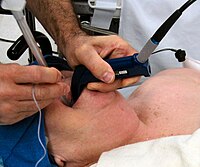
Photo from wikipedia
BACKGROUND The design of a videolaryngoscope blade may affect its efficacy. We classified videolaryngoscope blades as standard and non-standard shapes to compare their efficacy performing tracheal intubation in children enrolled… Click to show full abstract
BACKGROUND The design of a videolaryngoscope blade may affect its efficacy. We classified videolaryngoscope blades as standard and non-standard shapes to compare their efficacy performing tracheal intubation in children enrolled in the Paediatric Difficult Intubation Registry. METHODS Cases entered in the Registry from March 2017 to January 2020 were analysed. We compared the success rates of initial and eventual tracheal intubation, complications, and technical difficulties between the two groups and by weight stratification. RESULTS Videolaryngoscopy was used in 1313 patients. Standard and non-standard blades were used in 529 and 740 patients, respectively. Both types were used in 44 patients. In children weighing <5 kg, standard blades had significantly greater success than non-standard blades at initial (51% vs 26%, P=0.002) and eventual (81% vs 58%, P=0.002) attempts at tracheal intubation. In multivariable logistic regression analysis, standard blades had 3-fold greater odds of success at initial tracheal intubations compared with non-standard blades (adjusted odds ratio 3.0, 95% confidence interval): 1.32-6.86, P=0.0009). Standard blades had 2.6-fold greater odds of success at eventual tracheal intubation compared with non-standard blades in children weighing <5 kg (adjusted odds ratio 2.6, 95% confidence interval: 1.08-6.25, P=0.033). There was no significant difference found in children weighing ≥5 kg. CONCLUSIONS In infants weighing <5 kg, videolaryngoscopy with standard blades was associated with a significantly greater success rate than videolaryngoscopy with non-standard blades. Videolaryngoscopy with a standard blade is a sensible choice for tracheal intubation in children who weigh <5 kg.
Journal Title: British journal of anaesthesia
Year Published: 2020
Link to full text (if available)
Share on Social Media: Sign Up to like & get
recommendations!